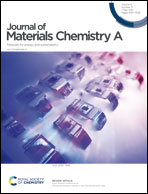High-rate aqueous zinc-ion batteries enabled by a polymer/graphene composite cathode involving reversible electrolyte anion doping/dedoping†
Abstract
It has long been of interest to explore cathode materials for achieving high-performance rechargeable zinc ion batteries through rational design and highly efficient synthesis. Based on the combination of reversible Zn2+ insertion/-extraction and electrolyte anion doping/dedoping mechanisms, a polymer/graphene composite cathode, named poly-quinol-phenylenediamine/graphene (POLA/G), is obtained via a hydrothermal synthesis method. The hydroquinone and p-phenylenediamine building blocks of POLA/G can not only provide a reversible redox reaction associated with Zn2+, but they can also interact with the anions in the aqueous electrolyte. As a result, Zn//POLA/G batteries deliver extremely good electrochemical performance, with a high-rate capability of 225 mA h g−1 at 0.1 A g−1 and 152 mA h g−1 at 20 A g−1. Moreover, the composite cathode presents exceptional long-term cycling performance, retaining 90% of its initial capacity after 5000 cycles at a current of 10 A g−1. Hence, this work develops a new direction for the use of polymers to increase zinc ion storage.



 Please wait while we load your content...
Please wait while we load your content...